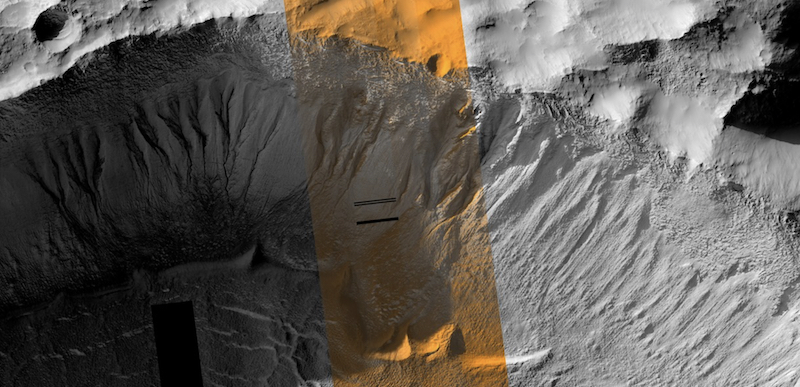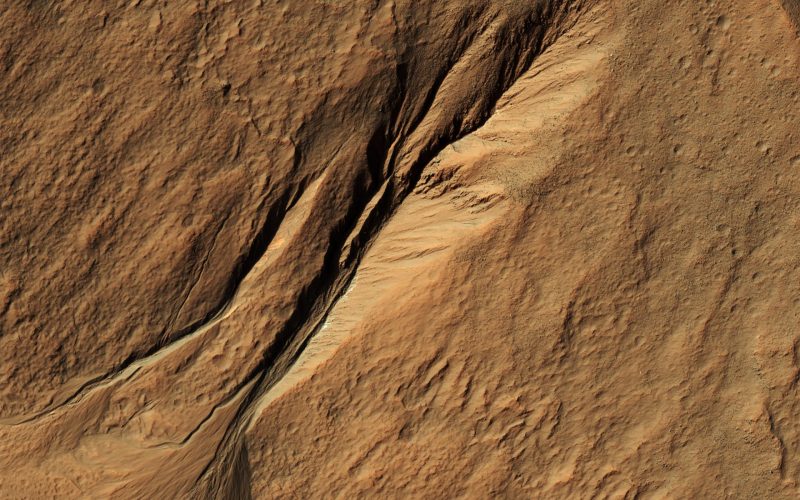
For decades, gullies on the slopes on Martian craters have intrigued scientists. They resemble gullies in Antarctica on Earth that form from glaciers’ melting ice. Is it the same on Mars? On June 29, 2023, a team of scientists led by researchers from Brown University announced that may indeed be the case. They said that on-off periods of liquid meltwater from ice beneath the surface could have formed the gullies.
The researchers published their peer-reviewed findings in the journal Science on June 29, 2023.
Did water or carbon dioxide create the gullies on Mars?
Some scientists had theorized that evaporating carbon dioxide frost caused the gullies. Other scientists, however, thought differently. They said that the distance the gullies traveled down the slopes and how eroded the gullies looked seemed more consistent with water. As the paper said:
Some steep slopes on Mars have gullies with morphologies suggesting that they were formed by a fluid. However, the planet’s current climate is not conducive to the melting of water ice at those locations, and mechanisms involving carbon dioxide ice do not explain the distribution of the gullies.
Lead author Jay Dickson, formerly at Brown University and now at Caltech, explained:
Our study shows that the global distribution of gullies is better explained by liquid water over the last million years. Water explains the elevation distribution of gullies in ways that CO2 cannot. This means that Mars has been able to create liquid water in enough volume to erode channels within the last million years, which is very recent on the scale of Mars geologic history.
Note that the gullies are different from the recurring slope lineae. Those are dark “wet-looking” streaks that run down slopes and then fade. They are just on the surface, unlike gullies that are carved into the terrain.
A sweet spot for liquid water
Mars today is bitterly cold, and the atmosphere is too thin for liquid water to remain on the surface. But the researchers said there is an occasional “sweet spot” for liquid water on Mars. This happens when the planet’s axis tilts to 35 degrees. During those times, the atmosphere becomes dense enough to allow brief periods of melting subsurface ice. The meltwater in some areas, such as the Terra Sirenum region, then flows downhill from high elevation points such as the rims of craters.
The researchers say these melting episodes have likely occurred many times over the past several million years. The most recent may have been about 630,000 years ago. At those times, temperatures rose above 273 degrees Kelvin, or about 32 degrees Fahrenheit (0 C).
Co-author Jim Head at Brown University said:
We know from a lot of our research and other people’s research that early on in Mars history, there was running water on the surface with valley networks and lakes. But about three billion years ago, all of that liquid water was lost, and Mars became what we call a hyper-arid or polar desert. We show here that even after that and in the recent past, when Mars’ axis tilts to 35 degrees, it heats up sufficiently to melt snow and ice, bringing liquid water back until temperatures drop and it freezes again.
The paper states:
Under these conditions, the atmospheric pressure at the gullies would be above the triple point of water, so it could melt to form a liquid.
Both water and carbon dioxide?
The researchers further propose that both water ice and carbon dioxide ice may be involved. As the paper explains:
We propose the following scenario for gully formation and evolution that incorporates both H2O and CO2 on the same slopes.
First, gullies formed during periods of high obliquity throughout the Amazonian period. Those conditions occurred several times in the past few million years, most recently ~630,000 years ago. Gully formation occurred at locations where conditions for liquid H2O were reached, which includes elevations up to ~4,500 meters.
Second, Mars returned to lower obliquity (25°). Melting of H2O ice ceased across Mars and sublimation dominated, leaving loose material that collected in gully channels and could be easily mobilized.
Finally, alcoves and channels now serve as cold traps for both H2O and CO2 seasonal frost and ice. Both CO2 and H2O undergo phase changes through the course of Mars’ year as temperatures vary, producing occasional and local modifications to gullies, as observed today.

Gullies on Mars similar to those in Antarctica
The water hypothesis is also supported simply by the appearance of the gullies. They closely resemble gullies in the McMurdo Dry Valleys of Antarctica. Despite the cold, the sun warms the ice just enough for meltwater to form and carve gullies in the ground.
The resemblance of the Martian gullies doesn’t prove that water made them as well. But together with all the other results from the study, it certainly adds to and supports the hypothesis.
Gullies and Martian life
Of course, if there has been liquid water, even just small amounts, then that raises the question of life. Could these periodic flows of meltwater be enough to support microbes? Maybe microbes could be dormant for long periods of time and then revive when the axis tilts again and liquid water becomes available, even if only briefly. Head said:
Could there be a bridge, if you will, between the early warm and wet Mars and the Mars that we see today in terms of liquid water? Everybody’s always looking for environments that could be conducive to not just the formation of life but the preservation and continuation of it. Any microorganism that might have evolved in early Mars is going to be in places where they can be comfortable in ice and then also comfortable or prosperous in liquid water. In the frigid Antarctic environment, for example, the few organisms that exist often occur in stasis, waiting for water.
It’s an intriguing possibility, and perhaps a future mission can go examine some of these gullies in-situ. Being able to do that when water was present would be even better, of course. Mars’ axis will eventually tilt back back to 35 degrees again, scientists say. Just not in our lifetimes, though. Oh well.
Bottom line: Were gullies on Mars formed by liquid water? A new study led by researchers at Brown University says that intermittent meltwater likely did indeed create them.
Source: Gullies on Mars could have formed by melting of water ice during periods of high obliquity











